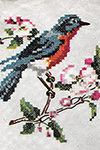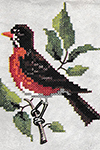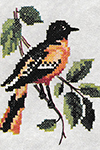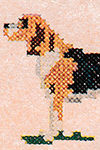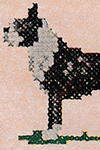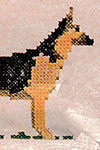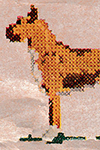Well-Known Birds | McCall's No. 2035
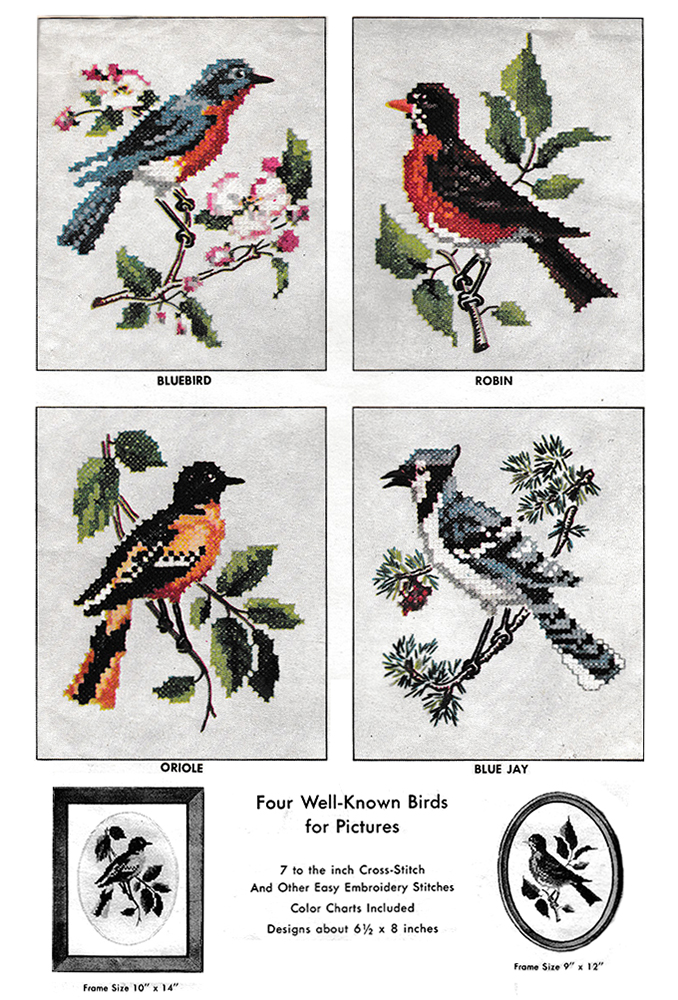
Well-Known Birds
Pattern 2035
McCall's Pattern Company
Original Copyright 1956
Pattern includes designs for four bird pictures. Design sizes are: Bluebird 7" x 7⅞", Robin 6½" x 8⅝", Oriole 6½" x 8¼", Blue Jay 6¾" x 7⅞". Leaflet includes charts for placing the colors and instructions for embroidery. Pictures are worked in 7-to-inch cross-stitch, satin, French knots, outline, back and single stitches.
MATERIALS REQUIRED: For Background use white, cream or egg shell color, medium weight smooth linen, linen-like cotton or good quality unbleached muslin. The four pictures require ¾ yd. 36" fabric (suitable for either frame treatment shown) using a piece about 13" x 18" for each picture. For Embroidery use six-strand embroidery cotton.
PICTURE FRAMES: The oval frame is 9" x 11", with 1¼" wide mahogany molding. The rectangular frame with oval mat is 10" x 14", with mahogany molding 1½" to 2" wide. The mat has oval inside opening about 8" x 11", with outside measurement ⅛" smaller than frame size. A 9" x 12" rectangular frame without mat (not shown) may be used if desired.
COLORS |
D.M.C. |
C • B |
Peri-Lusta |
Bucilla |
Coats & Clark's |
Black |
310 |
Black |
41 |
2001 |
12 |
White |
White |
White |
25A |
2003 |
1 |
Light Grey |
415 |
707 |
225 |
2286 |
70 |
Medium Grey |
414 |
708 |
226 |
2291 |
71 |
Dark Taupe |
640 |
157 |
707 |
2464 |
62 |
Dark Brown |
801 |
116 |
409C |
2566 |
81A |
Henna |
919 |
605 |
269 |
2460 |
134 |
Dark Orange |
900 |
145 |
466 |
2519 |
38B |
Orange |
922 |
602 |
482 |
2518 |
75 |
Yellow Orange |
740 |
132 |
260 |
2517 |
38 |
Light Yellow Orange |
742 |
130 |
155 |
2515 |
11 |
Yellow |
743 |
616 |
153 |
2576 |
43 |
Very Dark Green |
890 |
510 |
414C |
2410 |
109 |
Green |
904 |
673 |
913 |
2406 |
104 |
Bright Green |
700 |
984 |
901 |
2246 |
48A |
Light Yellow Green |
907 |
67 |
910 |
2060 |
5A |
Very Dark Blue |
336 |
746 |
320 |
2454 |
55 |
Dark Blue |
796 |
586 |
476 |
2452 |
44 |
Medium Blue |
798 |
584 |
489 |
2446 |
108 |
Blue |
799 |
583 |
488 |
2444 |
69 |
Dark Ross |
335 |
644 |
756 |
2430 |
59B |
Medium Rose |
3326 |
642 |
752 |
2428 |
46A |
Light Rose |
818 |
640 |
748 |
2426 |
2 |
Blue Jay Chart Pattern
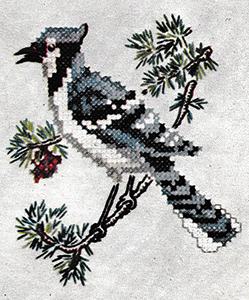
Pattern includes designs for four bird pictures. Design sizes are: Bluebird 7" x 7⅞", Robin 6½" x 8⅝", Oriole 6½" x 8¼", Blue Jay 6¾" x 7⅞". Leaflet includes charts for placing the colors and instructions for embroidery. Pictures are worked in 7-to-inch cross-stitch, satin, French knots, outline, back and single stitches.
MATERIALS REQUIRED: For Background use white, cream or egg shell color, medium weight smooth linen, linen-like cotton or good quality unbleached muslin. The four pictures require ¾ yd. 36" fabric (suitable for either frame treatment shown) using a piece about 13" x 18" for each picture. For Embroidery use six-strand embroidery cotton.
Cross-Stitch: Follow charts for placing colors. Use six-strands of cotton in needle. In working cross-stitch (see detail above) it is very important to have the crosses of the entire piece crossed in the same direction. Keep stitches as even as possible. Be sure all crosses touch. To do this, put needle in same hole as used for adjoining stitch.
Remaining Embroidery: Use six strands of cotton in needle for all work except outlining white portion of Blue Jay's tail and Robin's leg, where two strands are used. The stitches used are satin (inner lines indicate direction of stitches), French knots (one time around needle), outline, back and single stitch. After cross-stitch is finished, complete pictures as follows:
BLUE JAY: Eye—black satin stitch, center white French knot. Crest—outline stitch; front medium blue, back black. Beak—upper, dark brown satin stitch underlined in black outline stitch; tongue, black outline stitch; lower beak, black satin stitch. Legs and Feet— black outline stitch. Branches—dark brown outline stitch; inner lines, single stitch; section below left foot, henna; remainder dark brown. Pine Needles—single stitch; dotted lines . . . . light yellow green, broken lines - - - - green, solid lines —— very dark green. Outline white crosses of tail with medium grey back stitch.
To Block Design: Cover a large bread or drawing board with clean brown paper. Mark the size of fabric (13" x 18") on brown paper. If the embroidered piece is soiled, it may be washed, or if only slightly soiled dip in cleaning fluid. Place wet piece (right side up) on board, and pull edges of fabric to meet guide lines drawn on brown paper. Tack all edges of fabric to board, placing thumb tacks close together. Allow piece to remain on the board until thoroughly dry.
Before Framing: Mount embroidered pieces by stretching over pieces of stiff cardboard, cut smaller than frame size. If using oval frame, mounting board must be oval. In stretching, be sure to keep design perfectly straight and properly centered. Drive pins through fabric and edges of cardboard, beginning at centers of top, bottom and sides (widest points of oval), keeping fabric grain straight. Paste edges of fabric down on wrong side. When using oval board, it may be necessary to trim away excess fabric on wrong side to avoid bunching.
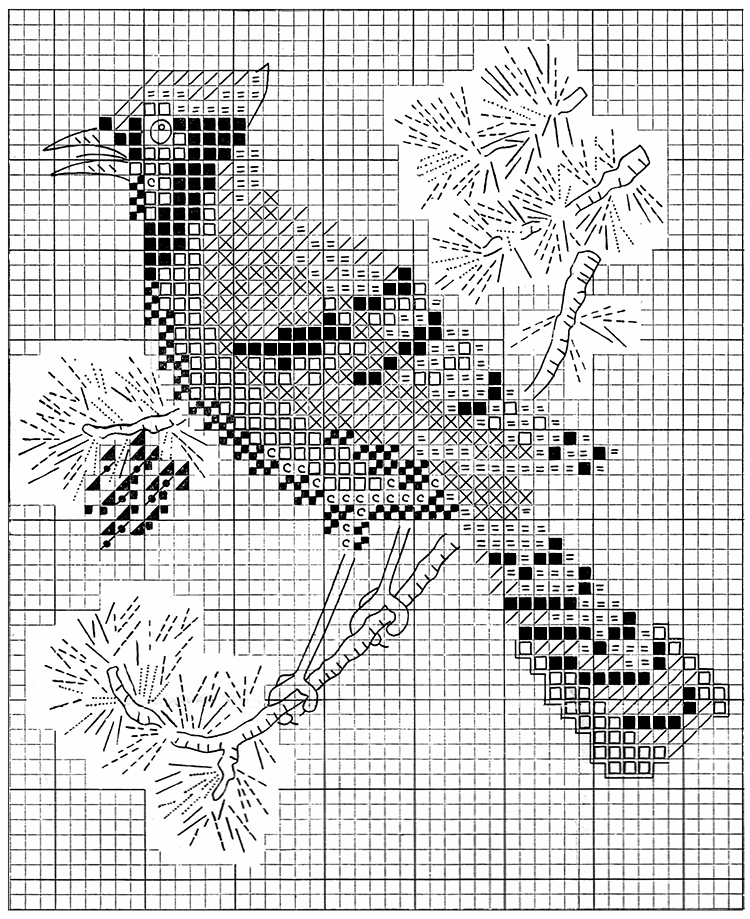

Oriole Chart Pattern
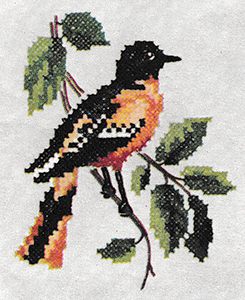
Pattern includes designs for four bird pictures. Design sizes are: Bluebird 7" x 7⅞", Robin 6½" x 8⅝", Oriole 6½" x 8¼", Blue Jay 6¾" x 7⅞". Leaflet includes charts for placing the colors and instructions for embroidery. Pictures are worked in 7-to-inch cross-stitch, satin, French knots, outline, back and single stitches.
MATERIALS REQUIRED: For Background use white, cream or egg shell color, medium weight smooth linen, linen-like cotton or good quality unbleached muslin. The four pictures require ¾ yd. 36" fabric (suitable for either frame treatment shown) using a piece about 13" x 18" for each picture. For Embroidery use six-strand embroidery cotton.
Cross-Stitch: Follow charts for placing colors. Use six-strands of cotton in needle. In working cross-stitch (see detail above) it is very important to have the crosses of the entire piece crossed in the same direction. Keep stitches as even as possible. Be sure all crosses touch. To do this, put needle in same hole as used for adjoining stitch.
Remaining Embroidery: Use six strands of cotton in needle for all work except outlining white portion of Blue Jay's tail and Robin's leg, where two strands are used. The stitches used are satin (inner lines indicate direction of stitches), French knots (one time around needle), outline, back and single stitch. After cross-stitch is finished, complete pictures as follows:
ORIOLE: Eye—black satin stitch; center white French knot. Eyebrow—very dark blue outline stitch. Beak—satin stitch; upper, very dark blue; lower, black. Legs and Feet— black outline stitch. Branch and Twigs—dark brown outline stitch.
To Block Design: Cover a large bread or drawing board with clean brown paper. Mark the size of fabric (13" x 18") on brown paper. If the embroidered piece is soiled, it may be washed, or if only slightly soiled dip in cleaning fluid. Place wet piece (right side up) on board, and pull edges of fabric to meet guide lines drawn on brown paper. Tack all edges of fabric to board, placing thumb tacks close together. Allow piece to remain on the board until thoroughly dry.
Before Framing: Mount embroidered pieces by stretching over pieces of stiff cardboard, cut smaller than frame size. If using oval frame, mounting board must be oval. In stretching, be sure to keep design perfectly straight and properly centered. Drive pins through fabric and edges of cardboard, beginning at centers of top, bottom and sides (widest points of oval), keeping fabric grain straight. Paste edges of fabric down on wrong side. When using oval board, it may be necessary to trim away excess fabric on wrong side to avoid bunching.

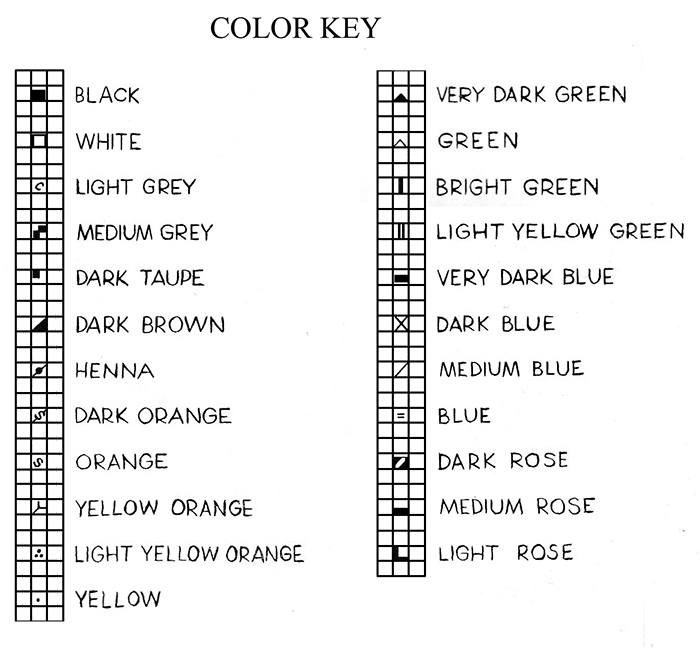
Robin Chart Pattern
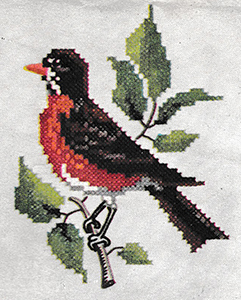
Pattern includes designs for four bird pictures. Design sizes are: Bluebird 7" x 7⅞", Robin 6½" x 8⅝", Oriole 6½" x 8¼", Blue Jay 6¾" x 7⅞". Leaflet includes charts for placing the colors and instructions for embroidery. Pictures are worked in 7-to-inch cross-stitch, satin, French knots, outline, back and single stitches.
MATERIALS REQUIRED: For Background use white, cream or egg shell color, medium weight smooth linen, linen-like cotton or good quality unbleached muslin. The four pictures require ¾ yd. 36" fabric (suitable for either frame treatment shown) using a piece about 13" x 18" for each picture. For Embroidery use six-strand embroidery cotton.
Cross-Stitch: Follow charts for placing colors. Use six-strands of cotton in needle. In working cross-stitch (see detail above) it is very important to have the crosses of the entire piece crossed in the same direction. Keep stitches as even as possible. Be sure all crosses touch. To do this, put needle in same hole as used for adjoining stitch.
Remaining Embroidery: Use six strands of cotton in needle for all work except outlining white portion of Blue Jay's tail and Robin's leg, where two strands are used. The stitches used are satin (inner lines indicate direction of stitches), French knots (one time around needle), outline, back and single stitch. After cross-stitch is finished, complete pictures as follows:
ROBIN: Eye—black satin stitch; center white French knot. Beak—satin stitch; upper light yellow orange, lower yellow orange. Legs and Feet—black outline stitch. Branch —outline stitch; upper side dark taupe, lower side and end dark brown; inner lines dark brown single stitch. Single Line Twigs—dark brown outline stitch. Outline white crosses on leg in medium grey back stitch.
To Block Design: Cover a large bread or drawing board with clean brown paper. Mark the size of fabric (13" x 18") on brown paper. If the embroidered piece is soiled, it may be washed, or if only slightly soiled dip in cleaning fluid. Place wet piece (right side up) on board, and pull edges of fabric to meet guide lines drawn on brown paper. Tack all edges of fabric to board, placing thumb tacks close together. Allow piece to remain on the board until thoroughly dry.
Before Framing: Mount embroidered pieces by stretching over pieces of stiff cardboard, cut smaller than frame size. If using oval frame, mounting board must be oval. In stretching, be sure to keep design perfectly straight and properly centered. Drive pins through fabric and edges of cardboard, beginning at centers of top, bottom and sides (widest points of oval), keeping fabric grain straight. Paste edges of fabric down on wrong side. When using oval board, it may be necessary to trim away excess fabric on wrong side to avoid bunching.
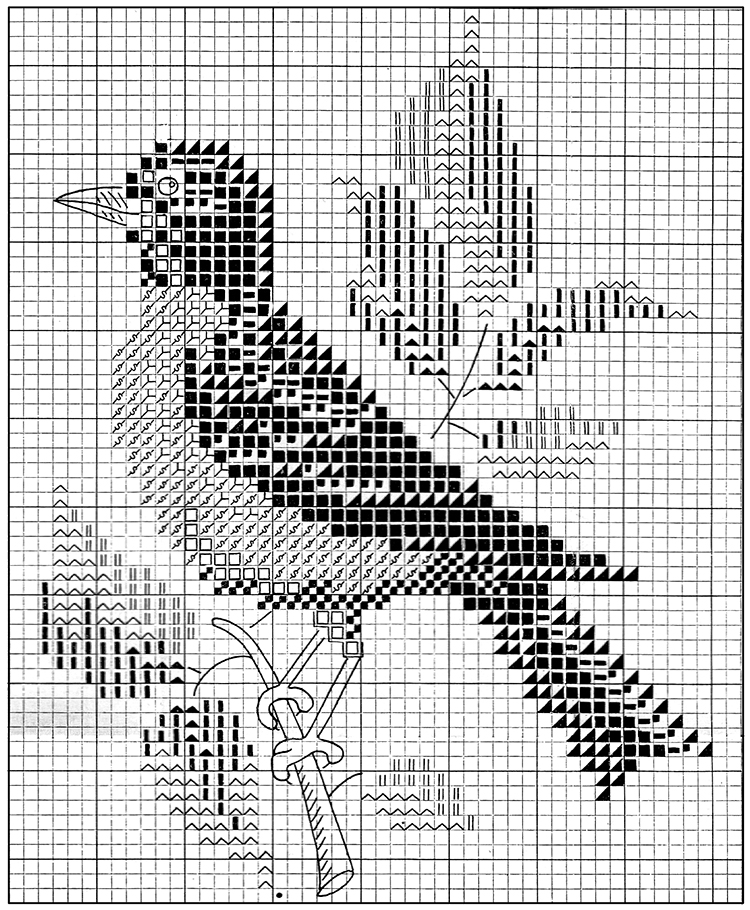
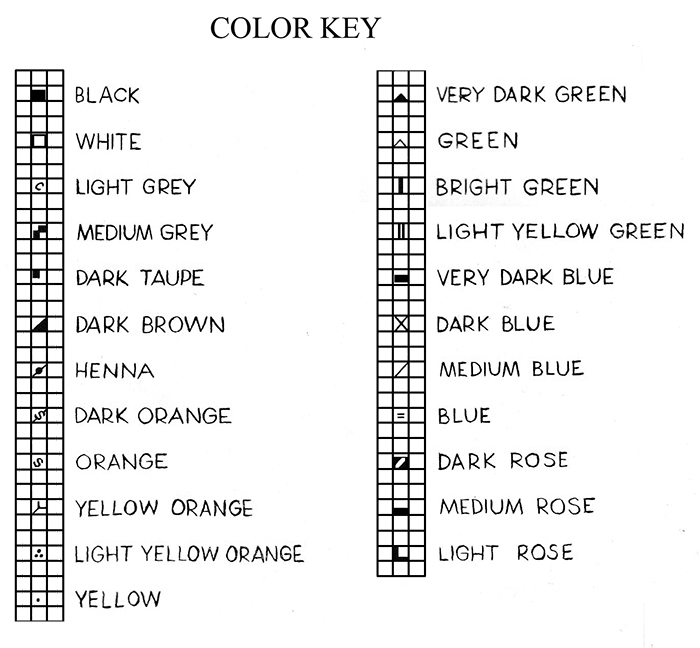
Bluebird Chart Pattern
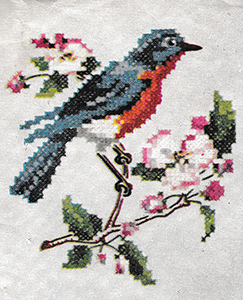
Pattern includes designs for four bird pictures. Design sizes are: Bluebird 7" x 7⅞", Robin 6½" x 8⅝", Oriole 6½" x 8¼", Blue Jay 6¾" x 7⅞". Leaflet includes charts for placing the colors and instructions for embroidery. Pictures are worked in 7-to-inch cross-stitch, satin, French knots, outline, back and single stitches.
MATERIALS REQUIRED: For Background use white, cream or egg shell color, medium weight smooth linen, linen-like cotton or good quality unbleached muslin. The four pictures require ¾ yd. 36" fabric (suitable for either frame treatment shown) using a piece about 13" x 18" for each picture. For Embroidery use six-strand embroidery cotton.
Cross-Stitch: Follow charts for placing colors. Use six-strands of cotton in needle. In working cross-stitch (see detail above) it is very important to have the crosses of the entire piece crossed in the same direction. Keep stitches as even as possible. Be sure all crosses touch. To do this, put needle in same hole as used for adjoining stitch.
Remaining Embroidery: Use six strands of cotton in needle for all work except outlining white portion of Blue Jay's tail and Robin's leg, where two strands are used. The stitches used are satin (inner lines indicate direction of stitches), French knots (one time around needle), outline, back and single stitch. After cross-stitch is finished, complete pictures as follows:
BLUEBIRD: Eye—black satin stitch; center white French knot. Eyebrow—medium blue outline stitch. Beak— satin stitch, upper beak dark brown, lower beak black. Legs and Feet—outline stitch, front sides dark brown; remainder black. Branch—dark brown outline stitch, inner lines dark brown single stitch. Single Line Twigs—green outline. Flower Centers—French knots; solid dots dark brown, open dots light yellow orange; short lines green single stitch.
To Block Design: Cover a large bread or drawing board with clean brown paper. Mark the size of fabric (13" x 18") on brown paper. If the embroidered piece is soiled, it may be washed, or if only slightly soiled dip in cleaning fluid. Place wet piece (right side up) on board, and pull edges of fabric to meet guide lines drawn on brown paper. Tack all edges of fabric to board, placing thumb tacks close together. Allow piece to remain on the board until thoroughly dry.
Before Framing: Mount embroidered pieces by stretching over pieces of stiff cardboard, cut smaller than frame size. If using oval frame, mounting board must be oval. In stretching, be sure to keep design perfectly straight and properly centered. Drive pins through fabric and edges of cardboard, beginning at centers of top, bottom and sides (widest points of oval), keeping fabric grain straight. Paste edges of fabric down on wrong side. When using oval board, it may be necessary to trim away excess fabric on wrong side to avoid bunching.
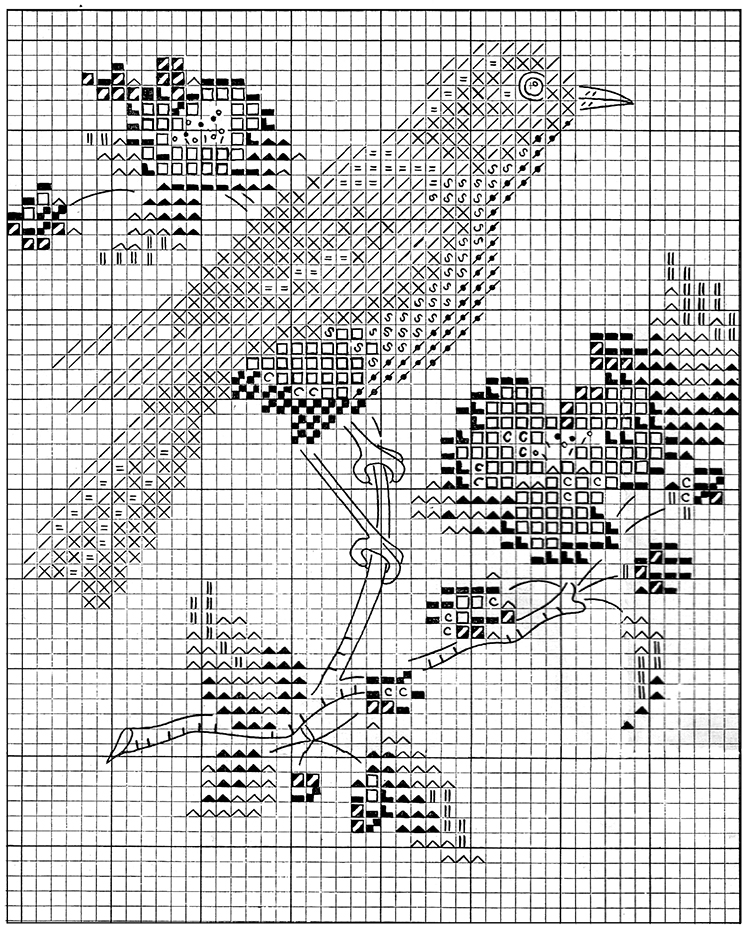
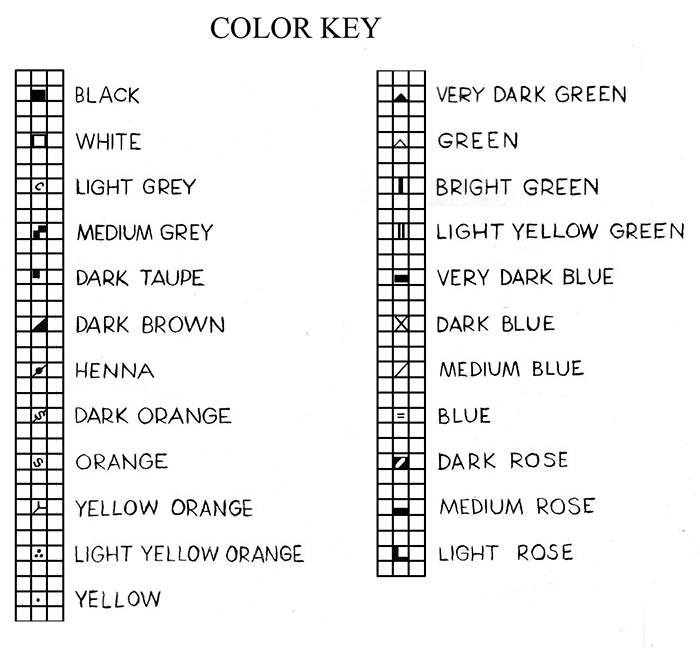
Dog Show | McCall's No. 1719
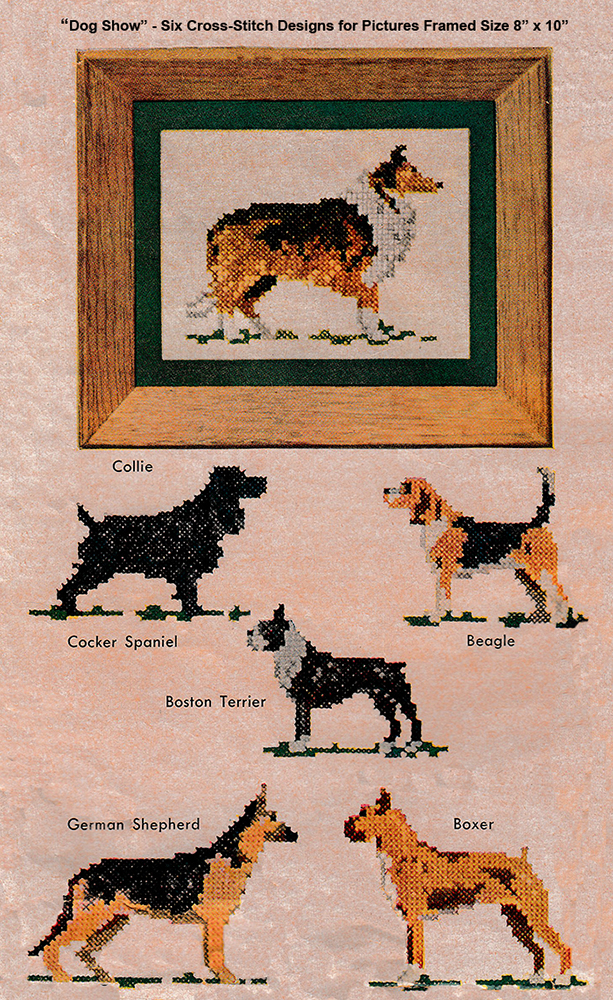
Dog Show
Pattern 1719
McCall's Pattern Company
Original Copyright 1952
Pattern includes one each of six designs in 7 to the inch crosses for framed pictures, 8" x 10". Collie, 5⅜" x 6⅞"; Cocker Spaniel, 4⅛" x 6⅜"; Beagle, 4¼" x 5½"; Boston Terrier, 4⅛" x 5⅜"; German Shepherd, 5½" x 7⅛" and Boxer, 5⅜" x 6⅛".
MATERIALS REQUIRED: Smooth linen, medium weight linen-like cotton in white or unbleached muslin may be used for the background. For an 8" x 10" picture, use a piece of material about 12" x 14".
Boxer Chart Pattern
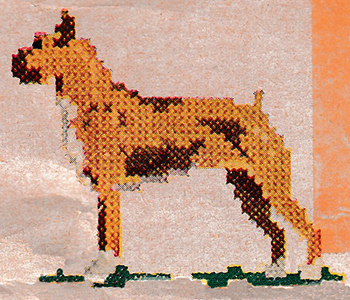
Pattern includes one each of six designs in 7 to the inch crosses for framed pictures, 8" x 10". Collie, 5⅜" x 6⅞"; Cocker Spaniel, 4⅛" x 6⅜"; Beagle, 4¼" x 5½"; Boston Terrier, 4⅛" x 5⅜"; German Shepherd, 5½" x 7⅛" and Boxer, 5⅜" x 6⅛".
MATERIALS REQUIRED: Smooth linen, medium weight linen-like cotton in white or unbleached muslin may be used for the background. For an 8" x 10" picture, use a piece of material about 12" x 14". See framing directions below.
EMBROIDERY COTTONS: Six-strand embroidery cotton should be used for the work. The set of six pictures requires one skein each of very dark brown, dark brown, medium dark brown, medium brown, gold, dark toast, toast, medium grey, dark green, medium green, light green, dark beige, light beige, medium blue grey, and 2 skeins each of navy, very deep gold, deep gold, dark grey and white and 4 skeins of black; a total of 28 skeins. One single dog requires one skein of each color with the following exception: the Cocker Spaniel requires 2 skeins of black and the Boxer, 2 skeins of very deep gold (instead of one skein).
CROSS-STITCH: Follow the chart in the pattern for placing the colors and use six strands of cotton in the needle for all work. It is very important when working cross-stitch to have the crosses of the entire piece crossed in the same direction. Whether one starts at the left and works right, or whether one starts right and works toward the left is optional. Keep the stitches as even as possible. Be sure to make all crosses touch. To do this, put the needle in the same hole as used for the adjoining stitch.
TO BLOCK DESIGN: Cover a large bread or drawing board with clean brown wrapping paper. Mark the size of linen rectangle, 12" x 14" on the brown paper. If the embroidered piece is badly soiled, it may be washed; if slightly soiled, dip in cleaning fluid. Place the wet piece (right side up) on the board, pull edges of linen to meet the guide lines drawn on the brown paper. Tack all edges of linen to the board, placing the thumb tacks close together. Allow the piece to remain on board until thoroughly dry.
BEFORE FRAMING: The embroidered piece should be stretched over a stiff piece of cardboard, cut to fit the frame. In stretching the material, be sure to keep the design perfectly straight. Pins driven through the material and into the edge of cardboard will be helpful in keeping the material straight. Paste edge of material down on the wrong side.
SUGGESTION FOR FRAMING: The frame illustrated is a raw wood frame 1¾" wide, size 8" x 10". The green mat cut to fit the frame has a 6" x 8" opening, thus leaving a 1" margin all around.
NOTE: If desired, the design may be worked in needlepoint.
DESIGN WORKED IN NEEDLEPOINT: The dogs illustrated were worked in cross-stitch, crosses 7 to the inch, on a linen background. If desired, the dogs may be worked in needlepoint on needlepoint canvas, following the charts. The charts are given in squares 10 to the inch which is a popular size for needlepoint canvas.
MATERIALS (CANVAS AND WOOL): Ten mesh to the inch canvas is suitable for one strand of tapestry wool or three strands of crewel wool. Use a piece of canvas 2 inches larger than the finished background size to allow for blocking. When buying wool, match colors to the illustrations. Use white or cream to fill in the background. The approximate amount of wool required may be figured by working one square inch of the background and checking the amount of wool used in relation to the yardage of the skein. One 12½-yard skein of tapestry wool embroiders about 5 square inches of canvas, 10 meshes to the inch, one strand in the needle.
CONTINENTAL NEEDLEPOINT STITCH: Start the design at the upper right hand corner, working each color from, right to left, then fill in the background. To begin work, hold an inch of wool in the back, working over this portion as you do your needlepoint. All other strands of wool may be started and finished by weaving in and out of the wrong side of finished work. Work back and forth, turning work upside down to work back, working from right to left as in details 1 and 2 at right.
BLOCKING: Use a smooth surface board, cover with brown paper and mark the size of canvas on this, squaring the corners. Place needlepoint right side down over the guide, true edges of canvas to the guide lines and fasten with thumb tacks placed ¾” apart along edges. Wet thoroughly with cold water and leave in position until thoroughly dry. Frame.
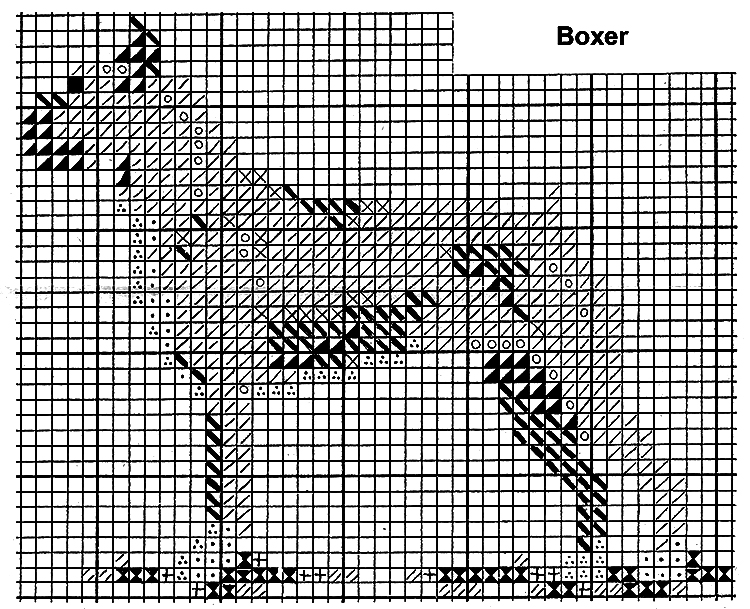
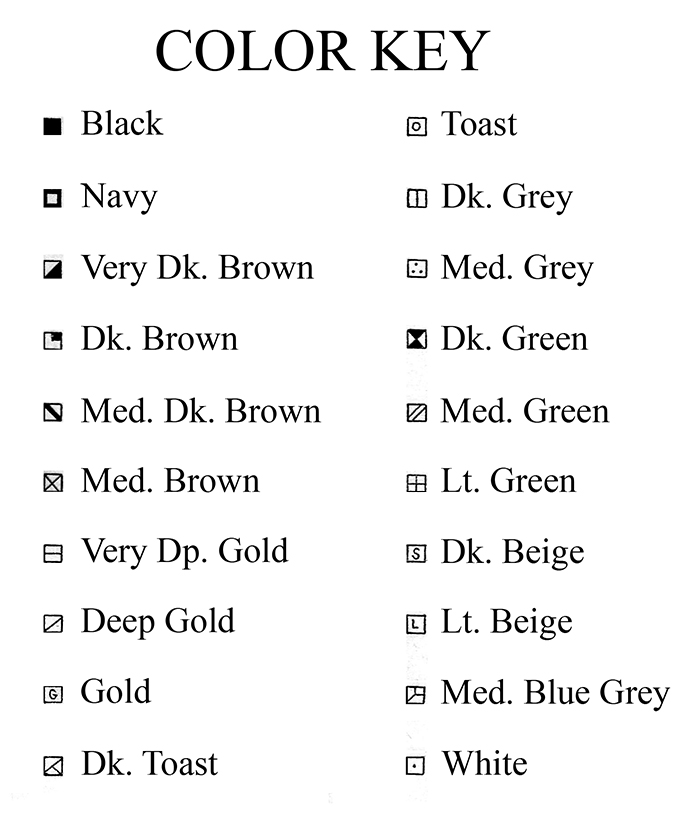
German Shepherd Chart Pattern
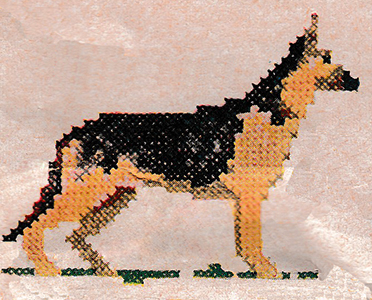
Pattern includes one each of six designs in 7 to the inch crosses for framed pictures, 8" x 10". Collie, 5⅜" x 6⅞"; Cocker Spaniel, 4⅛" x 6⅜"; Beagle, 4¼" x 5½"; Boston Terrier, 4⅛" x 5⅜"; German Shepherd, 5½" x 7⅛" and Boxer, 5⅜" x 6⅛".
MATERIALS REQUIRED: Smooth linen, medium weight linen-like cotton in white or unbleached muslin may be used for the background. For an 8" x 10" picture, use a piece of material about 12" x 14". See framing directions below.
EMBROIDERY COTTONS: Six-strand embroidery cotton should be used for the work. The set of six pictures requires one skein each of very dark brown, dark brown, medium dark brown, medium brown, gold, dark toast, toast, medium grey, dark green, medium green, light green, dark beige, light beige, medium blue grey, and 2 skeins each of navy, very deep gold, deep gold, dark grey and white and 4 skeins of black; a total of 28 skeins. One single dog requires one skein of each color with the following exception: the Cocker Spaniel requires 2 skeins of black and the Boxer, 2 skeins of very deep gold (instead of one skein).
CROSS-STITCH: Follow the chart in the pattern for placing the colors and use six strands of cotton in the needle for all work. It is very important when working cross-stitch to have the crosses of the entire piece crossed in the same direction. Whether one starts at the left and works right, or whether one starts right and works toward the left is optional. Keep the stitches as even as possible. Be sure to make all crosses touch. To do this, put the needle in the same hole as used for the adjoining stitch.
TO BLOCK DESIGN: Cover a large bread or drawing board with clean brown wrapping paper. Mark the size of linen rectangle, 12" x 14" on the brown paper. If the embroidered piece is badly soiled, it may be washed; if slightly soiled, dip in cleaning fluid. Place the wet piece (right side up) on the board, pull edges of linen to meet the guide lines drawn on the brown paper. Tack all edges of linen to the board, placing the thumb tacks close together. Allow the piece to remain on board until thoroughly dry.
BEFORE FRAMING: The embroidered piece should be stretched over a stiff piece of cardboard, cut to fit the frame. In stretching the material, be sure to keep the design perfectly straight. Pins driven through the material and into the edge of cardboard will be helpful in keeping the material straight. Paste edge of material down on the wrong side.
SUGGESTION FOR FRAMING: The frame illustrated is a raw wood frame 1¾" wide, size 8" x 10". The green mat cut to fit the frame has a 6" x 8" opening, thus leaving a 1" margin all around.
NOTE: If desired, the design may be worked in needlepoint.
DESIGN WORKED IN NEEDLEPOINT: The dogs illustrated were worked in cross-stitch, crosses 7 to the inch, on a linen background. If desired, the dogs may be worked in needlepoint on needlepoint canvas, following the charts. The charts are given in squares 10 to the inch which is a popular size for needlepoint canvas.
MATERIALS (CANVAS AND WOOL): Ten mesh to the inch canvas is suitable for one strand of tapestry wool or three strands of crewel wool. Use a piece of canvas 2 inches larger than the finished background size to allow for blocking. When buying wool, match colors to the illustrations. Use white or cream to fill in the background. The approximate amount of wool required may be figured by working one square inch of the background and checking the amount of wool used in relation to the yardage of the skein. One 12½-yard skein of tapestry wool embroiders about 5 square inches of canvas, 10 meshes to the inch, one strand in the needle.
CONTINENTAL NEEDLEPOINT STITCH: Start the design at the upper right hand corner, working each color from, right to left, then fill in the background. To begin work, hold an inch of wool in the back, working over this portion as you do your needlepoint. All other strands of wool may be started and finished by weaving in and out of the wrong side of finished work. Work back and forth, turning work upside down to work back, working from right to left as in details 1 and 2 at right.
BLOCKING: Use a smooth surface board, cover with brown paper and mark the size of canvas on this, squaring the corners. Place needlepoint right side down over the guide, true edges of canvas to the guide lines and fasten with thumb tacks placed ¾” apart along edges. Wet thoroughly with cold water and leave in position until thoroughly dry. Frame.
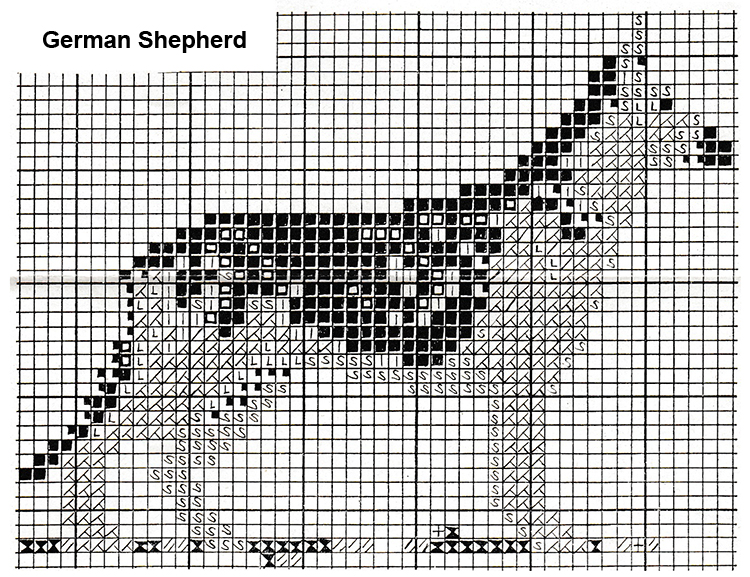
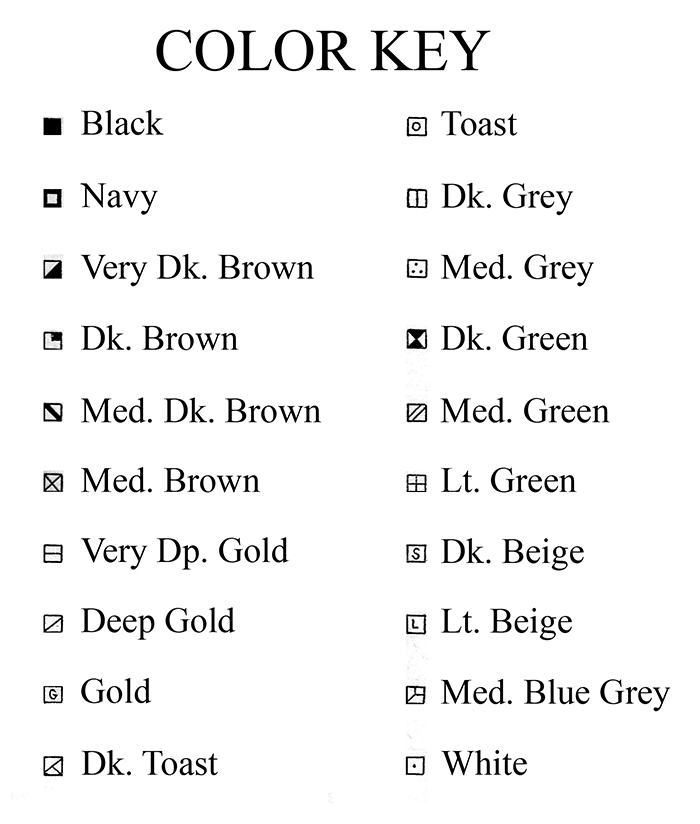
Boston Terrier Chart Pattern
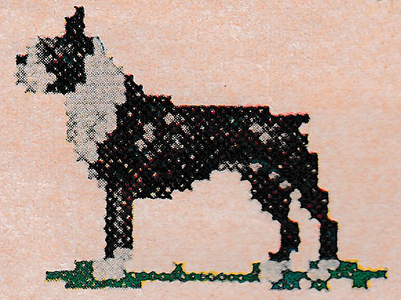
Pattern includes one each of six designs in 7 to the inch crosses for framed pictures, 8" x 10". Collie, 5⅜" x 6⅞"; Cocker Spaniel, 4⅛" x 6⅜"; Beagle, 4¼" x 5½"; Boston Terrier, 4⅛" x 5⅜"; German Shepherd, 5½" x 7⅛" and Boxer, 5⅜" x 6⅛".
MATERIALS REQUIRED: Smooth linen, medium weight linen-like cotton in white or unbleached muslin may be used for the background. For an 8" x 10" picture, use a piece of material about 12" x 14". See framing directions below.
EMBROIDERY COTTONS: Six-strand embroidery cotton should be used for the work. The set of six pictures requires one skein each of very dark brown, dark brown, medium dark brown, medium brown, gold, dark toast, toast, medium grey, dark green, medium green, light green, dark beige, light beige, medium blue grey, and 2 skeins each of navy, very deep gold, deep gold, dark grey and white and 4 skeins of black; a total of 28 skeins. One single dog requires one skein of each color with the following exception: the Cocker Spaniel requires 2 skeins of black and the Boxer, 2 skeins of very deep gold (instead of one skein).
CROSS-STITCH: Follow the chart in the pattern for placing the colors and use six strands of cotton in the needle for all work. It is very important when working cross-stitch to have the crosses of the entire piece crossed in the same direction. Whether one starts at the left and works right, or whether one starts right and works toward the left is optional. Keep the stitches as even as possible. Be sure to make all crosses touch. To do this, put the needle in the same hole as used for the adjoining stitch.
TO BLOCK DESIGN: Cover a large bread or drawing board with clean brown wrapping paper. Mark the size of linen rectangle, 12" x 14" on the brown paper. If the embroidered piece is badly soiled, it may be washed; if slightly soiled, dip in cleaning fluid. Place the wet piece (right side up) on the board, pull edges of linen to meet the guide lines drawn on the brown paper. Tack all edges of linen to the board, placing the thumb tacks close together. Allow the piece to remain on board until thoroughly dry.
BEFORE FRAMING: The embroidered piece should be stretched over a stiff piece of cardboard, cut to fit the frame. In stretching the material, be sure to keep the design perfectly straight. Pins driven through the material and into the edge of cardboard will be helpful in keeping the material straight. Paste edge of material down on the wrong side.
SUGGESTION FOR FRAMING: The frame illustrated is a raw wood frame 1¾" wide, size 8" x 10". The green mat cut to fit the frame has a 6" x 8" opening, thus leaving a 1" margin all around.
NOTE: If desired, the design may be worked in needlepoint.
DESIGN WORKED IN NEEDLEPOINT: The dogs illustrated were worked in cross-stitch, crosses 7 to the inch, on a linen background. If desired, the dogs may be worked in needlepoint on needlepoint canvas, following the charts. The charts are given in squares 10 to the inch which is a popular size for needlepoint canvas.
MATERIALS (CANVAS AND WOOL): Ten mesh to the inch canvas is suitable for one strand of tapestry wool or three strands of crewel wool. Use a piece of canvas 2 inches larger than the finished background size to allow for blocking. When buying wool, match colors to the illustrations. Use white or cream to fill in the background. The approximate amount of wool required may be figured by working one square inch of the background and checking the amount of wool used in relation to the yardage of the skein. One 12½-yard skein of tapestry wool embroiders about 5 square inches of canvas, 10 meshes to the inch, one strand in the needle.
CONTINENTAL NEEDLEPOINT STITCH: Start the design at the upper right hand corner, working each color from, right to left, then fill in the background. To begin work, hold an inch of wool in the back, working over this portion as you do your needlepoint. All other strands of wool may be started and finished by weaving in and out of the wrong side of finished work. Work back and forth, turning work upside down to work back, working from right to left as in details 1 and 2 at right.
BLOCKING: Use a smooth surface board, cover with brown paper and mark the size of canvas on this, squaring the corners. Place needlepoint right side down over the guide, true edges of canvas to the guide lines and fasten with thumb tacks placed ¾” apart along edges. Wet thoroughly with cold water and leave in position until thoroughly dry. Frame.
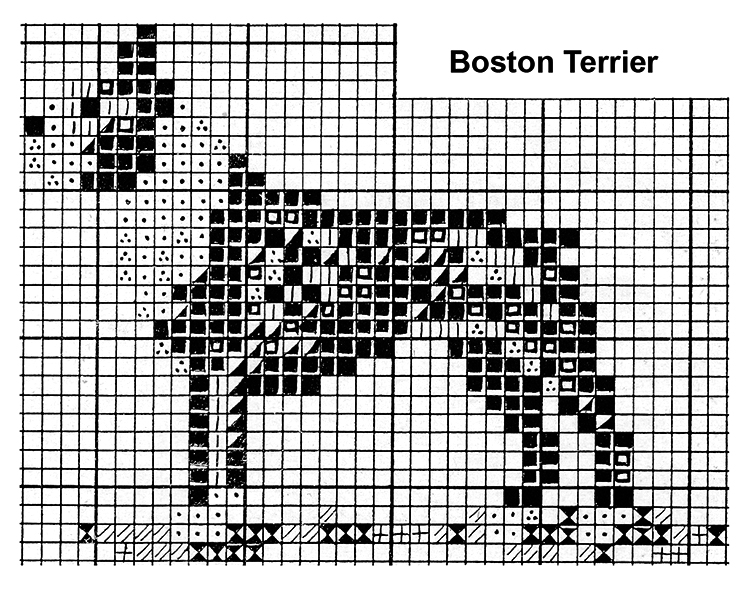
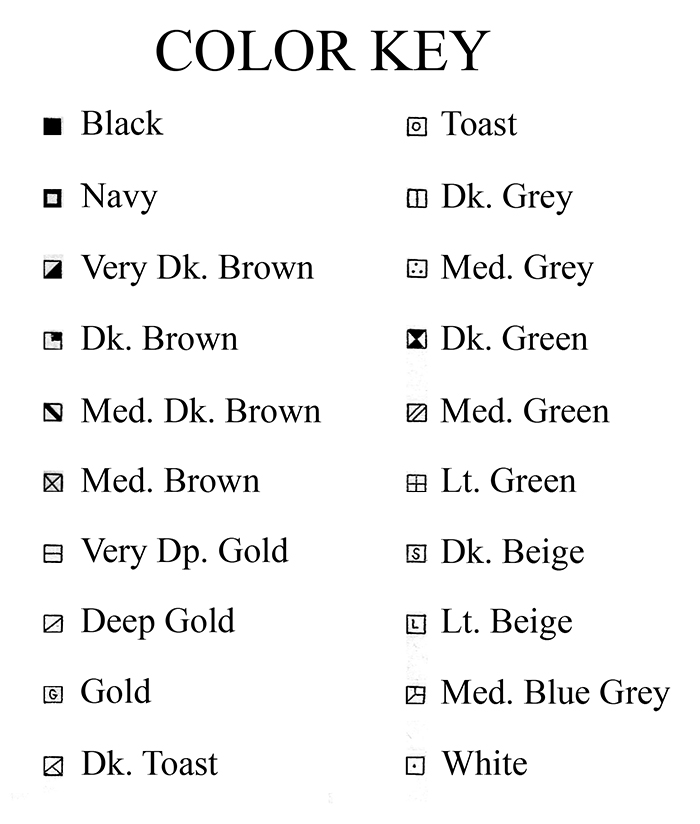
Beagle Chart Pattern
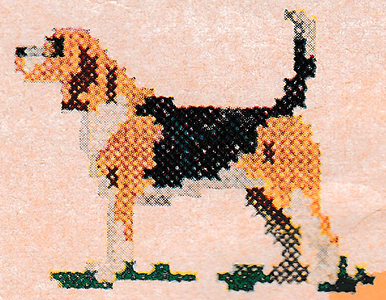
Pattern includes one each of six designs in 7 to the inch crosses for framed pictures, 8" x 10". Collie, 5⅜" x 6⅞"; Cocker Spaniel, 4⅛" x 6⅜"; Beagle, 4¼" x 5½"; Boston Terrier, 4⅛" x 5⅜"; German Shepherd, 5½" x 7⅛" and Boxer, 5⅜" x 6⅛".
MATERIALS REQUIRED: Smooth linen, medium weight linen-like cotton in white or unbleached muslin may be used for the background. For an 8" x 10" picture, use a piece of material about 12" x 14". See framing directions below.
EMBROIDERY COTTONS: Six-strand embroidery cotton should be used for the work. The set of six pictures requires one skein each of very dark brown, dark brown, medium dark brown, medium brown, gold, dark toast, toast, medium grey, dark green, medium green, light green, dark beige, light beige, medium blue grey, and 2 skeins each of navy, very deep gold, deep gold, dark grey and white and 4 skeins of black; a total of 28 skeins. One single dog requires one skein of each color with the following exception: the Cocker Spaniel requires 2 skeins of black and the Boxer, 2 skeins of very deep gold (instead of one skein).
CROSS-STITCH: Follow the chart in the pattern for placing the colors and use six strands of cotton in the needle for all work. It is very important when working cross-stitch to have the crosses of the entire piece crossed in the same direction. Whether one starts at the left and works right, or whether one starts right and works toward the left is optional. Keep the stitches as even as possible. Be sure to make all crosses touch. To do this, put the needle in the same hole as used for the adjoining stitch.
TO BLOCK DESIGN: Cover a large bread or drawing board with clean brown wrapping paper. Mark the size of linen rectangle, 12" x 14" on the brown paper. If the embroidered piece is badly soiled, it may be washed; if slightly soiled, dip in cleaning fluid. Place the wet piece (right side up) on the board, pull edges of linen to meet the guide lines drawn on the brown paper. Tack all edges of linen to the board, placing the thumb tacks close together. Allow the piece to remain on board until thoroughly dry.
BEFORE FRAMING: The embroidered piece should be stretched over a stiff piece of cardboard, cut to fit the frame. In stretching the material, be sure to keep the design perfectly straight. Pins driven through the material and into the edge of cardboard will be helpful in keeping the material straight. Paste edge of material down on the wrong side.
SUGGESTION FOR FRAMING: The frame illustrated is a raw wood frame 1¾" wide, size 8" x 10". The green mat cut to fit the frame has a 6" x 8" opening, thus leaving a 1" margin all around.
NOTE: If desired, the design may be worked in needlepoint.
DESIGN WORKED IN NEEDLEPOINT: The dogs illustrated were worked in cross-stitch, crosses 7 to the inch, on a linen background. If desired, the dogs may be worked in needlepoint on needlepoint canvas, following the charts. The charts are given in squares 10 to the inch which is a popular size for needlepoint canvas.
MATERIALS (CANVAS AND WOOL): Ten mesh to the inch canvas is suitable for one strand of tapestry wool or three strands of crewel wool. Use a piece of canvas 2 inches larger than the finished background size to allow for blocking. When buying wool, match colors to the illustrations. Use white or cream to fill in the background. The approximate amount of wool required may be figured by working one square inch of the background and checking the amount of wool used in relation to the yardage of the skein. One 12½-yard skein of tapestry wool embroiders about 5 square inches of canvas, 10 meshes to the inch, one strand in the needle.
CONTINENTAL NEEDLEPOINT STITCH: Start the design at the upper right hand corner, working each color from, right to left, then fill in the background. To begin work, hold an inch of wool in the back, working over this portion as you do your needlepoint. All other strands of wool may be started and finished by weaving in and out of the wrong side of finished work. Work back and forth, turning work upside down to work back, working from right to left as in details 1 and 2 at right.
BLOCKING: Use a smooth surface board, cover with brown paper and mark the size of canvas on this, squaring the corners. Place needlepoint right side down over the guide, true edges of canvas to the guide lines and fasten with thumb tacks placed ¾” apart along edges. Wet thoroughly with cold water and leave in position until thoroughly dry. Frame.

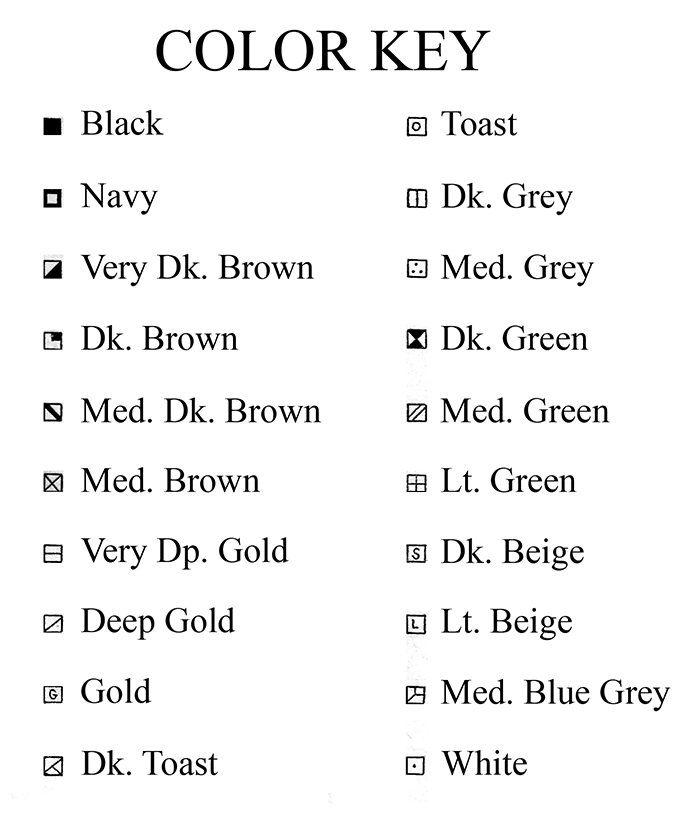
| Pattern Categories Browse the categories to help you find the patterns you're looking for. |
||

